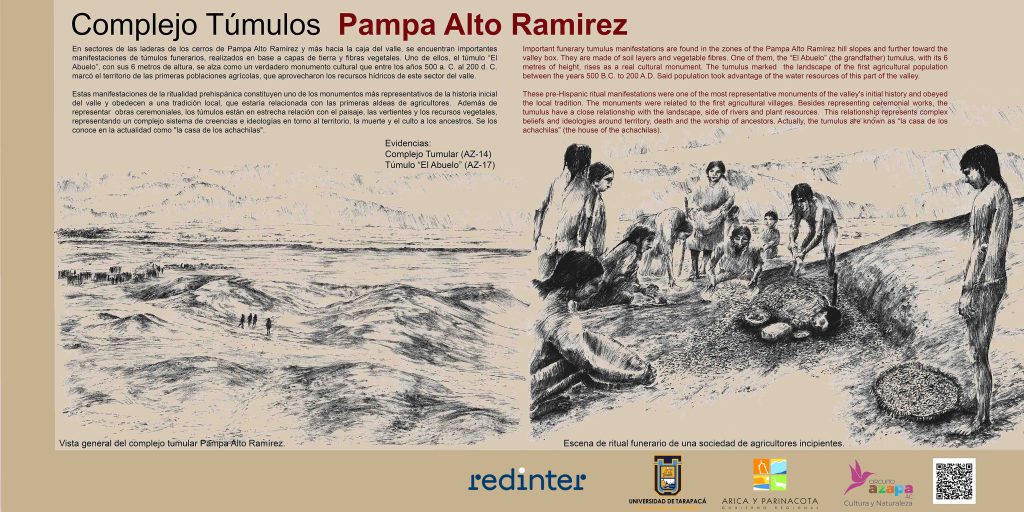Complejo “Túmulos Pampa Alto Ramírez” (“Túmulo Pampa Alto Ramírez” complex)
Complejo “Túmulos Pampa Alto Ramírez”
Km 8 – 9,5 Ruta A-133
(19 K 374760.00 m E 7951409.00 m N)
Evidencias:
-Complejo Tumular (AZ-14)
-Túmulo “El Abuelo” (AZ-17)
“Túmulo Pampa Alto Ramírez” complex
Km 8 – 9.5 Route A-133
(19 K 374760.00 m E 7951409.00 m N)
Evidences:
-Tumulus complex (AZ-14)
-“El Abuelo” tumulus (AZ-17)
En sectores de las laderas de los cerros de Pampa Alto Ramírez y más hacia la caja del valle, se encuentran importantes manifestaciones de túmulos funerarios, realizados en base a capas de tierra y fibras vegetales. Uno de ellos, el túmulo “El Abuelo”, con sus 6 metros de altura, se alza como un verdadero monumento cultural que entre los años 500 a. C. al 500 d. C. marcó el territorio de las primeras poblaciones agrícolas, que aprovecharon los recursos hídricos de este sector del valle.
Estas manifestaciones de la ritualidad prehispánica constituyen uno de los monumentos más representativos de la historia inicial del valle y obedecen a una tradición local, que estaría relacionada con las primeras aldeas de agricultores. Además de representar obras ceremoniales, los túmulos están en estrecha relación con el paisaje, las vertientes y los recursos vegetales, representando un complejo sistema de creencias e ideologías en torno al territorio, la muerte y el culto a los ancestros. Se los conoce en la actualidad como “la casa de los achachilas”.
Important funerary tumulus manifestations are found in the zones of the Pampa Alto Ramírez hill slopes and further toward the valley box. They are made of soil layers and vegetable fibres. One of them, the “El Abuelo” (the grandfather) tumulus, with its 6 metres of height, rises as a real cultural monument. The tumulus marked the landscape of the first agricultural population between the years 500 B.C. to 200 A.D. Said population took advantage of the water resources of this part of the valley.
These pre-Hispanic ritual manifestations were one of the most representative monuments of the valley’s initial history and obeyed the local tradition. The monuments were related to the first agricultural villages. Besides representing ceremonial works, the tumulus have a close relationship with the landscape, side of rivers and plant resources. This relationship represents complex beliefs and ideologies around territory, death and the worship of ancestors. Actually, the tumulus are known as “la casa de los achachilas” (the house of the achachilas).
